By Brandon Staley
Defensive Coordinator/Secondary Coach
John Carroll University (OH)
Twitter: @CoachStaley_JCU
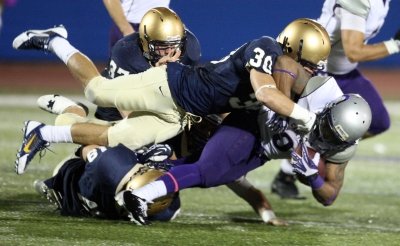 Introduction:
Introduction:
Do you need a way to deny the ball on 3rd down in a “Gotta Have It” type situation?
Do you need a coverage that will deny in-breaking route concepts, which occur primarily on 3rd down when the ball is on a hash?
Do you need a coverage that can eliminate a great player on the backside of 3 x 1?
Do you need a coverage that has coverage answers to the outside in case an Offense runs their 3rd down concepts based on leverage?
Let me introduce you to a coverage at John Carroll that we call “Buster.”
Defining Buster Coverage:
“Buster” is a deny-the-inside 2-man concept that protects your defense against the weakness of 2-man coverage, which is number two to the flat. At JCU, we usually play “Buster” in our Dime Rabbits Personnel grouping, which includes six defensive backs, one linebacker and our four best pass rushers. We are a defense that is predicated on matching up, especially on 3rd down when we are playing some version of man-to-man.
“Buster” is a concept that we play to a 3 receiver side. In 3 x 1 it’s easy; you automatically have your 3 man side. (Diagram 1) In 2 x 2, the 3 man side becomes wherever the offset back is (Diagram 2). Away from the “Buster” side, we just play regular 2-man coverage, which we call “Macho.” This is a traditional trail technique that we will discuss in detail later. If it’s 2 x 2 and it’s Pistol or under center, than we just play “Macho” to both sides and the Middle LB (MAC) will have the RB man-to-man.
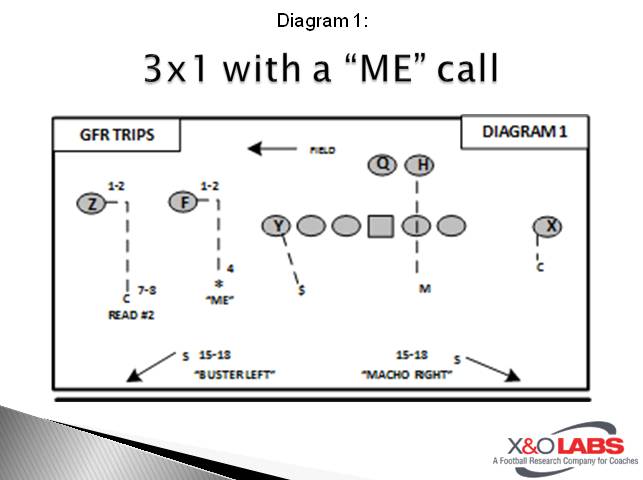
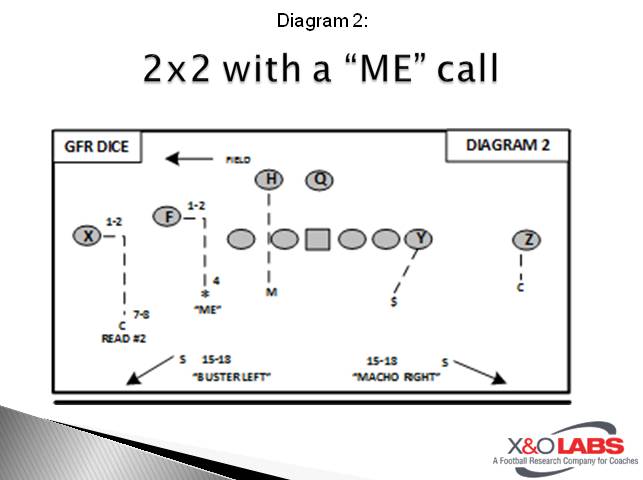
Buster Corner Technique:
The essence of “Buster” is the corner technique. We play “Off” to the “Buster” side at 7-8 yards deep and 1-2 yards inside. We want to give the illusion that we are playing some form of zone (3 deep, quarters, 2 deep). The corner to the “Buster” side reads the #2 receiver and traps the flat if #2 comes out in the first 5 yards of the pattern. The slot defender then “cuts” to the #1 receiver and plays him man-to-man.
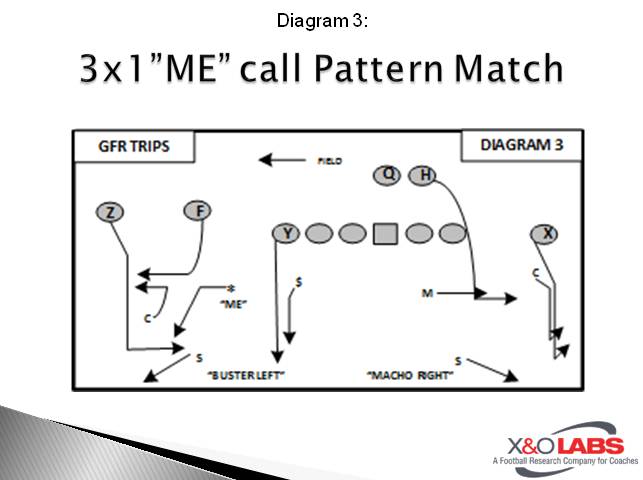
If the #2 receiver goes under or pushes vertical, then the corner “sinks” with the #1 receiver and plays trail technique on him. For advanced players and coaches, you can have the corner “roll over” on the deep sail route at 15-18 yards after you have “sunk” with the #1 receiver. It’s the most difficult route concept for the slot defender because he has to cover a long ways, but if you have the corner “roll over,” you have a built in trap that the QB will never see.
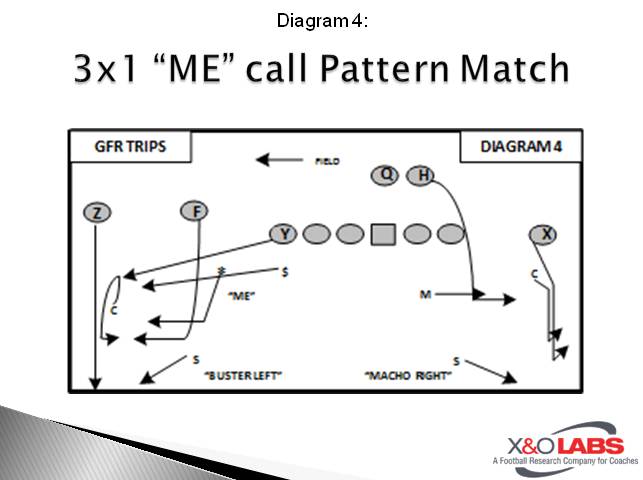
On the “Buster” side, the slot defender’s communication is critical. He is charged with assigning “Me” or “You” depending on the split of the #2 receiver. If the #2 receiver has a normal split, he communicates “Me” which tells the defender to his inside that he has #2. In a “Me” call, the defender inside the slot defender automatically has #3. It doesn’t matter if the formation is 2 x 2 or 3 x 1, all the slot defender is concerned with is the split of the #2 receiver to the “Buster” side.
If the #2 receiver has a tight split and he can’t play his inside leverage, he communicates “You,” which tells the defender inside that “You” have the deeper of #2 and #3 (Diagram #5). In a “You” call, the slot defender plays outside technique and delivers the #2 receiver to the inside defender. Remember, we are playing Dime Personnel, so that inside defender is usually a safety. In any 2 behind 3 scenario (Drive), the inside defender takes #2 and the slot defender pushes to undercut #3. A “You” call can also occur in 2 x 2 (Diagram 6).
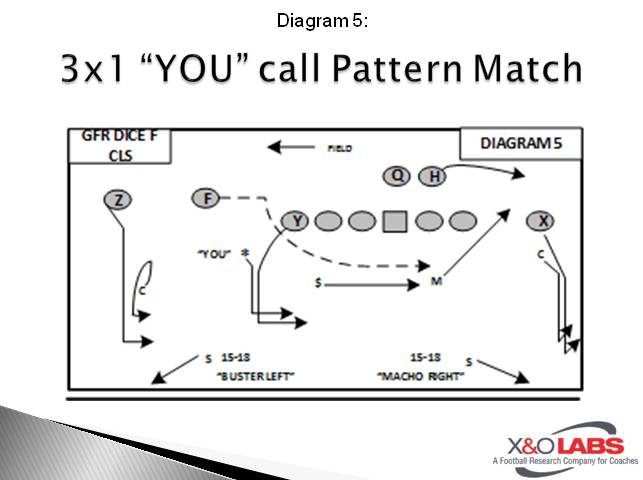
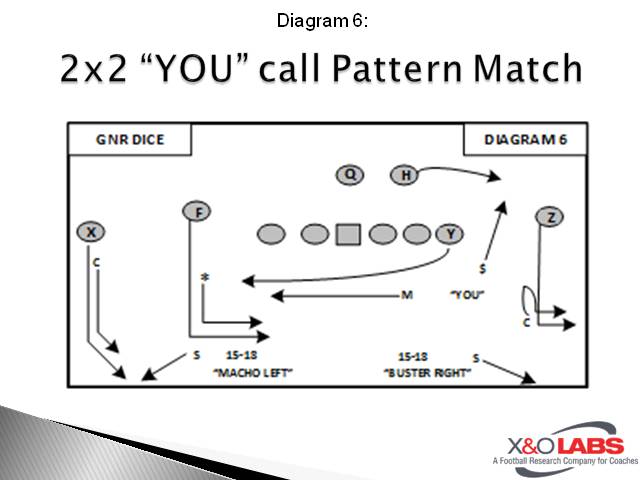
Trouble Shooting “Buster”:
Issues that ALWAYS need to cover on any down, but particularly 3rd down are 2-man stacks and 3-man bunches. The details of these difficult scenarios are critical to your success because if teams can’t win at the line of scrimmage vs. man-to-man, they will try and create access for their players to get open.
“Buster” vs. Stack:
Within the “Buster” concept, we play “Stack” to 2-man stacks, wh
Defensive Coordinator/Secondary Coach
John Carroll University (OH)
Twitter: @CoachStaley_JCU
 Introduction:
Introduction:Do you need a way to deny the ball on 3rd down in a “Gotta Have It” type situation?
Do you need a coverage that will deny in-breaking route concepts, which occur primarily on 3rd down when the ball is on a hash?
Do you need a coverage that can eliminate a great player on the backside of 3 x 1?
Do you need a coverage that has coverage answers to the outside in case an Offense runs their 3rd down concepts based on leverage?
Let me introduce you to a coverage at John Carroll that we call “Buster.”
Defining Buster Coverage:
“Buster” is a deny-the-inside 2-man concept that protects your defense against the weakness of 2-man coverage, which is number two to the flat. At JCU, we usually play “Buster” in our Dime Rabbits Personnel grouping, which includes six defensive backs, one linebacker and our four best pass rushers. We are a defense that is predicated on matching up, especially on 3rd down when we are playing some version of man-to-man.
“Buster” is a concept that we play to a 3 receiver side. In 3 x 1 it’s easy; you automatically have your 3 man side. (Diagram 1) In 2 x 2, the 3 man side becomes wherever the offset back is (Diagram 2). Away from the “Buster” side, we just play regular 2-man coverage, which we call “Macho.” This is a traditional trail technique that we will discuss in detail later. If it’s 2 x 2 and it’s Pistol or under center, than we just play “Macho” to both sides and the Middle LB (MAC) will have the RB man-to-man.


Buster Corner Technique:
The essence of “Buster” is the corner technique. We play “Off” to the “Buster” side at 7-8 yards deep and 1-2 yards inside. We want to give the illusion that we are playing some form of zone (3 deep, quarters, 2 deep). The corner to the “Buster” side reads the #2 receiver and traps the flat if #2 comes out in the first 5 yards of the pattern. The slot defender then “cuts” to the #1 receiver and plays him man-to-man.

If the #2 receiver goes under or pushes vertical, then the corner “sinks” with the #1 receiver and plays trail technique on him. For advanced players and coaches, you can have the corner “roll over” on the deep sail route at 15-18 yards after you have “sunk” with the #1 receiver. It’s the most difficult route concept for the slot defender because he has to cover a long ways, but if you have the corner “roll over,” you have a built in trap that the QB will never see.

On the “Buster” side, the slot defender’s communication is critical. He is charged with assigning “Me” or “You” depending on the split of the #2 receiver. If the #2 receiver has a normal split, he communicates “Me” which tells the defender to his inside that he has #2. In a “Me” call, the defender inside the slot defender automatically has #3. It doesn’t matter if the formation is 2 x 2 or 3 x 1, all the slot defender is concerned with is the split of the #2 receiver to the “Buster” side.
If the #2 receiver has a tight split and he can’t play his inside leverage, he communicates “You,” which tells the defender inside that “You” have the deeper of #2 and #3 (Diagram #5). In a “You” call, the slot defender plays outside technique and delivers the #2 receiver to the inside defender. Remember, we are playing Dime Personnel, so that inside defender is usually a safety. In any 2 behind 3 scenario (Drive), the inside defender takes #2 and the slot defender pushes to undercut #3. A “You” call can also occur in 2 x 2 (Diagram 6).


Trouble Shooting “Buster”:
Issues that ALWAYS need to cover on any down, but particularly 3rd down are 2-man stacks and 3-man bunches. The details of these difficult scenarios are critical to your success because if teams can’t win at the line of scrimmage vs. man-to-man, they will try and create access for their players to get open.
“Buster” vs. Stack:
Within the “Buster” concept, we play “Stack” to 2-man stacks, wh








